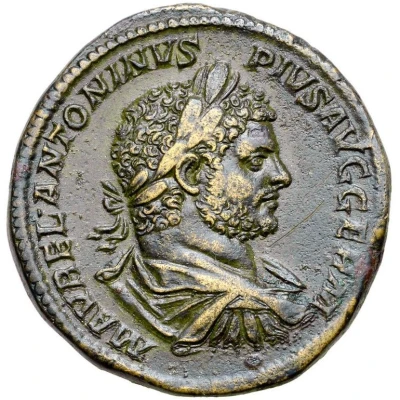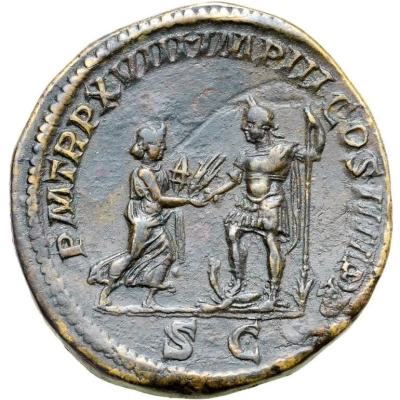


© Roma Numismatics Limited
Sestertius - Caracalla P M TR P XVIII IMP III COS IIII P P S C; Isis
215 year| Bronze | 25.2 g | 31.5 mm |
| Issuer | Rome › Roman Empire (27 BC - 395 AD) |
|---|---|
| Emperor | Caracalla (Marcus Aurelius Antoninus Caracalla) (198-217) |
| Type | Standard circulation coin |
| Year | 215 |
| Value | Sestertius (⅛) |
| Currency | Antoninianus, Reform of Caracalla (AD 215 – 301) |
| Composition | Bronze |
| Weight | 25.2 g |
| Diameter | 31.5 mm |
| Shape | Round (irregular) |
| Technique | Hammered |
| Demonetized | Yes |
| Updated | 2024-10-05 |
| Numista | N#273939 |
|---|---|
| Rarity index | 100% |
Reverse
Caracalla, in military attire, standing left, resting left foot on crocodile, holding spear in left hand; opposite him, Isis, draped, advancing right, holding two corn-ears in right hand and sistrum in left hand.
Script: Latin
Lettering: P M TR P XVIII IMP III COS IIII P P S C
Translation:
Pontifex Maximus, Tribunicia Potestate Octava Decima, Imperator Tertium, Consul Quartum, Pater Patriae. Senatus Consultum.
High priest, holder of tribunician power for the 18th time, supreme commander (Imperator) for the third time, consul for the fourth time, father of the nation. Decree of the senate.
Comment
Mass varies: 20.09–28.47 g;Diameter varies: 30–33 mm;
Example of this type:
American Numismatic Society (ANS)
This type records the infamous visit of Caracalla to Alexandria, the capital of the province of Egypt. Since the conclusion of his campaign against the Alamanni in 213-4, it had become apparent that the emperor was unhealthily obsessed with the great Macedonian conqueror Alexander the Great. At this point he appears to have begun openly emulating Alexander in his personal style. Indeed, Cassius Dio (78.7-78.23) relates that "he was so enthusiastic about Alexander that he used certain weapons and cups which he believed had once been his, and he also set up many likenesses of him both in the camps and in Rome itself. He organised a phalanx, composed entirely of Macedonians, sixteen thousand strong, named it 'Alexander's phalanx', and equipped it with the arms that warriors had used in his day."
Caracalla's visit in 215 to Alexandria while on his way east should then have been a happy occasion. However the emperor, "hearing that he was ill-spoken of and ridiculed by them for various reasons, not the least of which was the murder of his brother... concealing his wrath and pretending that he longed to see them... first greeted [the leading citizens] cordially... and then put them to death. Then, having arrayed his whole army, he marched into the city, after first notifying all the inhabitants to remain at home and after occupying all the streets and all the roofs as well. And, to pass over the details of the calamities that then befell the wretched city, he slaughtered so many persons that he did not even venture to say anything about their number, but wrote to the senate that it was of no interest how many of them or who had died, since all had deserved to suffer this fate."
Source:
Online Coins of the Roman Empire (OCRE)
Interesting fact
One interesting fact about this coin is that it features the image of the goddess Isis on the reverse, indicating the influence of Egyptian culture and religion on the Roman Empire during the reign of Caracalla.